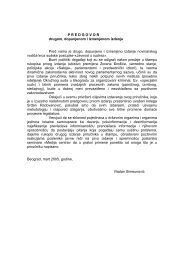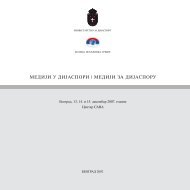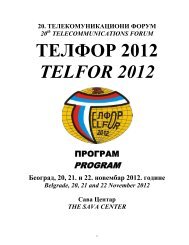Media Study - Medija centar Beograd
Media Study - Medija centar Beograd
Media Study - Medija centar Beograd
You also want an ePaper? Increase the reach of your titles
YUMPU automatically turns print PDFs into web optimized ePapers that Google loves.
28. “interconnection” means a physical or logical connection of telecommunications<br />
networks allowing the users of one network to communicate with the users of other<br />
networks, or to access the services provided by other telecommunications operators;<br />
29. “call back service” means a telecommunications service enabling a user from a<br />
given territory to receive, upon request, a reverse call from abroad to the user′s<br />
subscriber number;<br />
30. “numbering” means the allocation of numbers as part of total calling codes that<br />
enable establishing of telecommunications networks in certain areas or<br />
accomplishing certain telecommunications services;<br />
4<br />
31. “Internet service” means a telecommunications service realized by Internet<br />
technology;<br />
32. “leased line” means a non-switched telecommunications line between termination<br />
points of a fixed public telecommunications network, not including switching<br />
controlled by the user;<br />
33. “termination points” means the points for physical or logical connections of<br />
equipment or systems to the telecommunications network, or the points of<br />
interconnection among different telecommunications networks;<br />
34. “terminal equipment” means the equipment directly or indirectly connected to a<br />
termination point for the purpose of transmitting or receiving messages;<br />
35. “radio frequency” means the principle physical parameter of electromagnetic radio<br />
waves exhibiting free propagation through space and having values typically<br />
ranging between 9 kHz to 3,000 GHz;<br />
36. “radio frequency spectrum” means a defined range of radio frequencies;<br />
37. “radio communications” means telecommunications making use of radio waves;<br />
38. “radio station” means one or more transmitters or receivers, or a combination<br />
thereof, with one or more antennas and other equipment which are installed at one<br />
location and required for radio signal transmission, with the exception of a receiver<br />
for direct reception of radio signals;<br />
39. “amateur radio station” means a radio station used for amateur service;<br />
40. “base station” means a common name for all the radio and network communication<br />
equipment located at one fixed location used for communicating with network<br />
termination points in mobile network;<br />
41. “service zone” means a physical area in which it is possible to establish radio<br />
communications under certain conditions;<br />
42. “co-ordination” means a process of determining the service zone of a given radio<br />
communications system, provided that it does not cause any harmful interference to<br />
other neighbouring radio communications systems;<br />
43. “exclusive radio frequency” means a radio frequency assigned to only one radio<br />
station license holder, at one location, or in a specific service zone;<br />
44. “general radio frequency” means a radio frequency assigned to more than one radio<br />
station license holder, in a specific service zone, irrespective of the quality of radio<br />
communications;<br />
45. “interference” the effect of unwanted energy due to one or combination of<br />
emissions, radiations or induction upon reception in a radio communication system,<br />
manifested by any performance degradation, misinterpretation, or loss of<br />
information which could be extracted in the absence of such unwanted energy;<br />
46. “harmful interference” means an interference which endangers the functioning of a<br />
certain telecommunications systems in accordance with criteria for the quality of<br />
signal transmission;<br />
47. “electromagnetic compatibility (EMC)” means a capacity of telecommunications<br />
systems or equipment to function without emitting harmful interference;<br />
48. “significant market power” means that the share of a public telecommunications<br />
operator in the telecommunications market of the Republic of Serbia, measured by<br />
the number of users of a certain services provided by the public telecommunications<br />
operator within the scope of his activity, not below a prescribed percentage;<br />
49. “prescribed percentage,” means the share at least 20% in the telecommunications<br />
market in the Republic of Serbia, unless the Republic Telecommunications Agency<br />
determines otherwise for a certain type of service. The Republic<br />
5<br />
Telecommunications Agency may deviate by up to 25% from the percentage<br />
prescribed herein;<br />
50. “license” means a document issued by the relevant authority permitting an operator<br />
197









